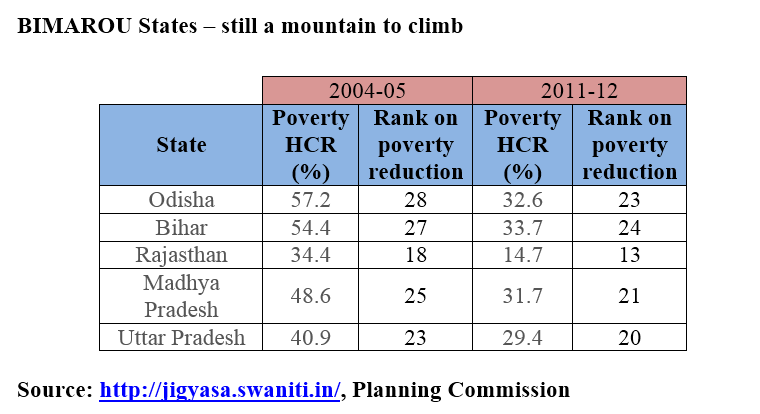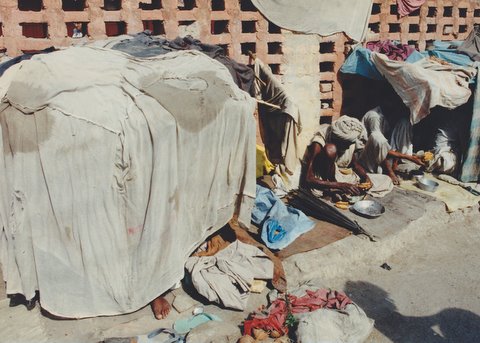Poverty And Prosperity In India: A Story of 28 States
The Government’s work should be to listen to the poor, to work for the poor, and live for (the poor)”, said Prime Minister Narendra Modi in his first speech in the 16th Lok Sabha. This was just a day after President Pranab Mukherjee said in his address at the joint session of Parliament that “my Government will not be satisfied with mere ‘poverty alleviation’ and commits itself to the goal of ‘poverty elimination’ .
The mandate for Modi is being seen, above all, as a mandate for development; development which is inclusive and which leads to empowerment of the poor and downtrodden.
So, how has India done on poverty alleviation in the last few years? Are there regional differences in the pattern of poverty alleviation? Is rapid economic growth a prerequisite for poverty alleviation? Which States in India have been most successful at bringing people out of poverty?
An analysis by Swaniti Initative, a development consulting firm which works with legislators, foundthat between 2004-05 and 2011-12, most states did well at poverty alleviation. 19 out of the 28 States managed a reduction in poverty by 10 percentage points or more. In other words, 19 states managed to pull out more than 10% of their total population out of poverty. 12 of them achieved a reduction greater than 15 percentage points.
Swaniti also tracks other metrics related to development and governance including health, education, livelihoods, women’s security and social inclusion on its online user-friendly data platform Jigyasa.
The Curious Case of the North-East
While the rest of the country was seeing a reduction in poverty, some of the north-east states actually saw a rise in poverty in this period. This is particularly surprising as most of these states had a significant rise in per capita income as shown below (Per-capita NDP for both years is at 2004-05 prices).
Tripura is a notable exception that bucked this trend. It saw a massive increase in per-capita NDP in this period and a sharp decline in poverty rates. From having the highest burden of poverty in 2004-05, it had the 2nd lowest poverty rate in 2011-12 among the seven north-east states.
Rich States Have Done Better
Is there a correlation between economic growth and poverty reduction? The table below analyses the performance of the seven richest states in terms of per-capita NDP in 2004-05.
Some of these rich States like Goa, Gujarat and Maharashtra had very high poverty rates. Others like Punjab, Haryana, Kerala and Himachal Pradesh had high per capita incomes as well as low poverty rates in 2004-05.
Rich States Better at Poverty Reduction; 2004-05 & 2011-12

* All these states did much better in poverty reduction in the seven-year period between 2004 and 2011, a period in which they continued to grow at high rates.
*Goa now has the highest per-capita NDP and the lowest poverty rate. Himachal Pradesh, Kerala, Punjab and Maharashtra have also improved their rank on poverty HCR in 2011-12 over 2004-05.
* Gujarat, despite high economic growth, continues to have a sizeable proportion of its population below the poverty line.

The BIMAROU (Bihar, Madhya Pradesh, Rajasthan, Odisha, Uttar Pradesh) states are known for their poor socio-economic indicators, especially the extremely high poverty periods. Between 2004-05 and 2011-12, most of these States did considerably well in poverty alleviation (see table below). However, despite these achievements, they are still ranked pretty low in 2011-12, indicating the need to do much more to catch up with the rest of the country.
“There does seem to be a correlation between economic growth and poverty reduction in most States,” said Rwitwika Bhattacharya, CEO of Swaniti. The top five growing states between 2004-05 and 2011-12 – Sikkim, Uttarakhand, Bihar, Maharashtra and Tamil Nadu –saw an improvement in their poverty ranks in the period. However, states with relatively modest growth rates, such as Tripura, have also done remarkably well at lifting people out of poverty.
IndiaSpend’s earlier reports (India Still Has 269 Million Poor, Bihar Leads Race In Reducing Poverty) (Rural Poverty Falls In Orissa, Urban Poverty Rises In Gujarat) had also pointed out that growth played a key role in poverty reduction.



